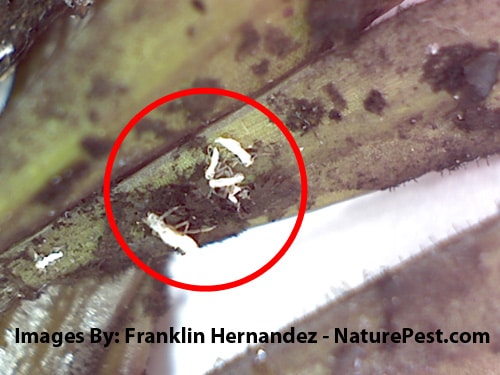This week during a routine inspection on a landscape dew for a quarterly treatment I noticed the Duranta Gold Mound hedge was a bit bare and upon close inspection I found a few branches that had what appeared to be aphids so I brought a sample back to examine it under a microscope to confirm the pest species and here is what I found. I have never come across aphids on Duranta, but as the saying goes there is a first time for everything. In this article, i will teach you how to control aphids on plants, trees, and shrubs.
The Background and Biology Of Aphids
Aphids or plant lice as they are called are soft bodied pear-shaped insects. The most distinguishing feature in the identification of aphids is the two short cornicle or tubes which extend from the end of their body.
Currently, there are approximately 1,375 species of aphids identified in the U.S. and Canada and approximately 4500 or more in the world.Most aphids, even adults, are wingless but when colonies become overcrowded or the host plant becomes undesirable, winged forms are produced and these establish new colonies.
Aphids have interesting and complicated life cycles. Aphids are unlike most insects in two ways: In Florida, almost all are females which reproduce without mating; and they seldom lay eggs, but give birth to living young. Aphids have the ability to reproduce rapidly and there are many generations per year. Each female aphid produces 50 to 100 daughters during her life span. Each daughter can begin reproducing in six to eight days.
Aphids are very troublesome to plants that are in shaded areas. When aphids feed on plants they cause the leaves to curl or crinkle. The flower buds may become hardened causing the flowers to be distorted.
Aphids excrete large amounts of honeydew which is a sugary liquid waste product. This provides a way for the growth of a black fungus called “sooty mold”. In addition to being unattractive, sooty mold interferes with photosynthesis and can retard the growth of the plant. Sooty mold usually is controlled by the control of the Aphid insect infestation.
Control Methods of Aphids
Bellow are two control methods i have included a link so you can purchase the products directly and get more information, labels, and MSDS.
Natural Aphid Control Method
Using a natural pesticide can be a good approach for the control aphids but require frequent inspections and reapplications upon finding them. If you find Aphids on your plants you can make a 3 natural spray application with EcoVia natural essential oil pesticide every five days to achieve control then re inspect every five days to ensure control. This is a great solution for fruit trees and other edible plants.
Systemic Aphid Control Method
Using a systemic insecticide such as Dominion 2L you can achieve a long term control without continues applications as long as 1 year for most species with just one application. This is not allowed for fruit trees as it can contaminate the fruit.This is considered an environmentally friendly pest control approach because you only have to apply the product once to a specific site, there is no spray drift and it will not harm beneficial and pollinating insects. The chemical lasts less than 120 days in the soil.












